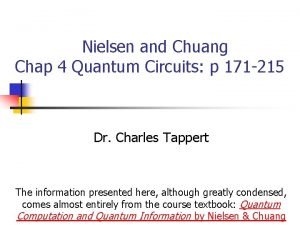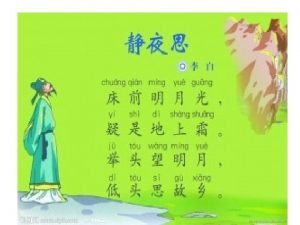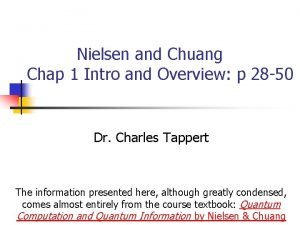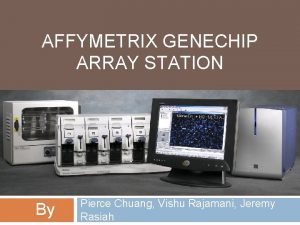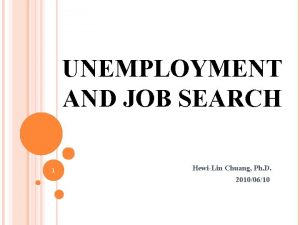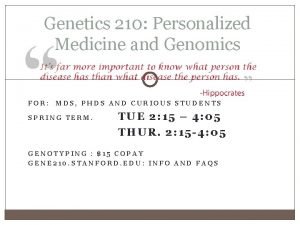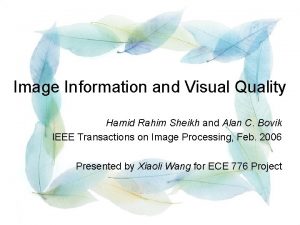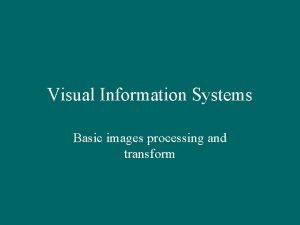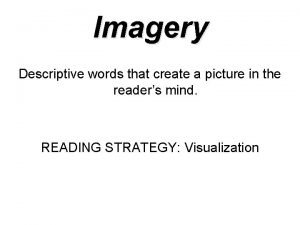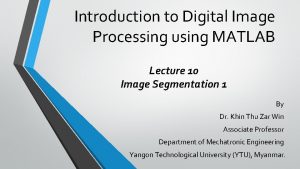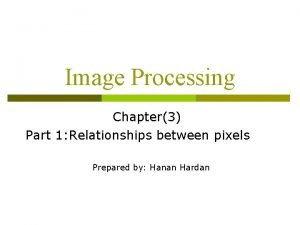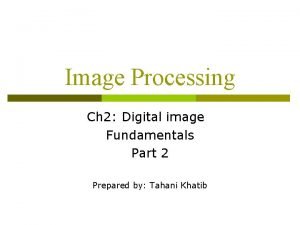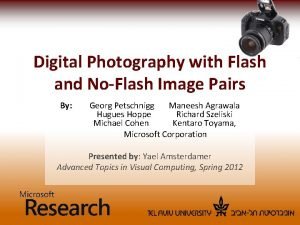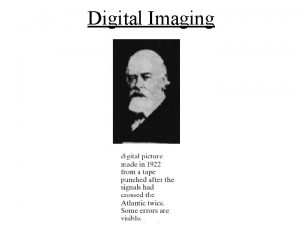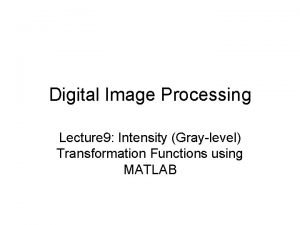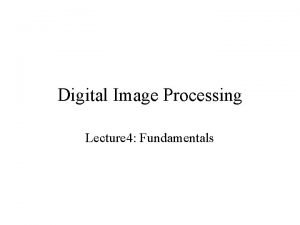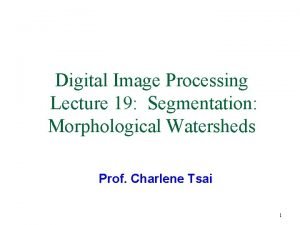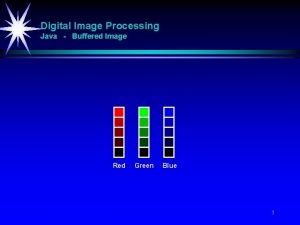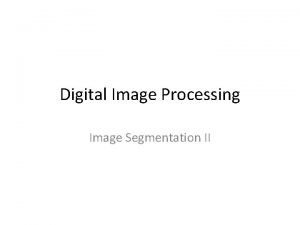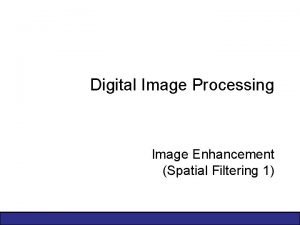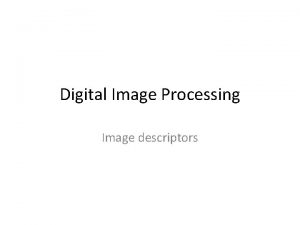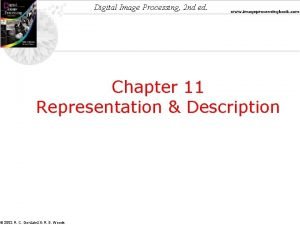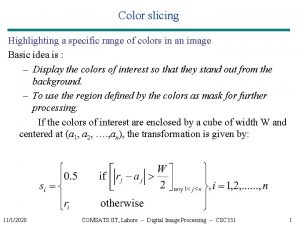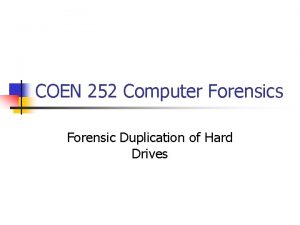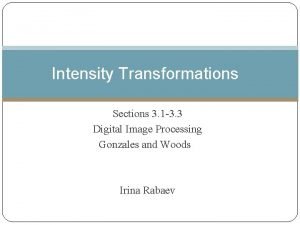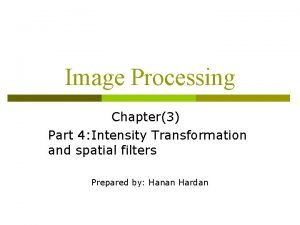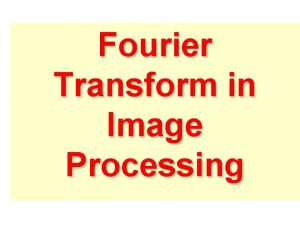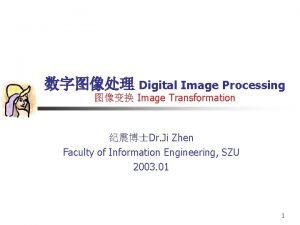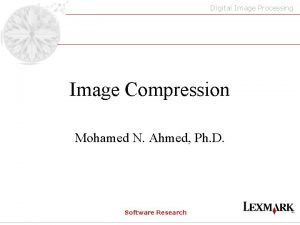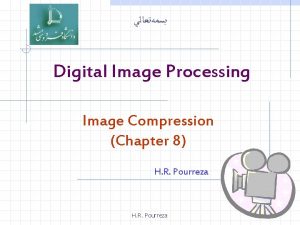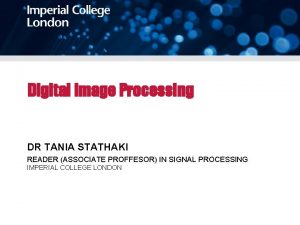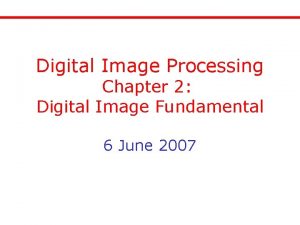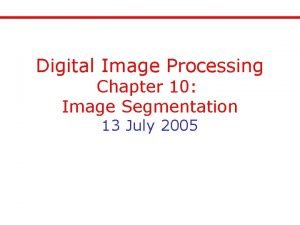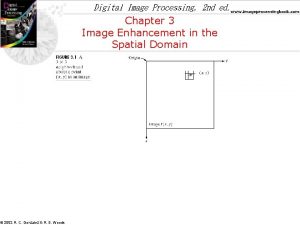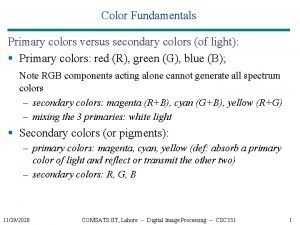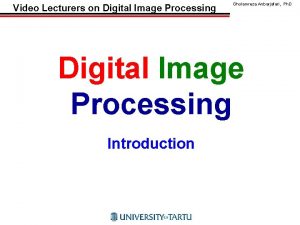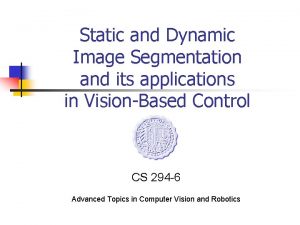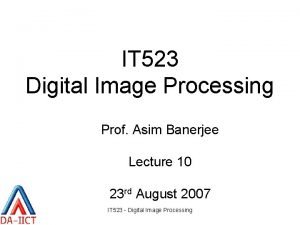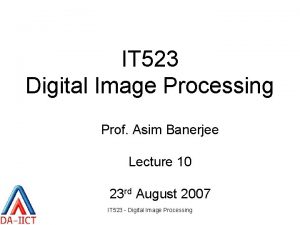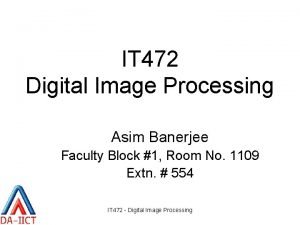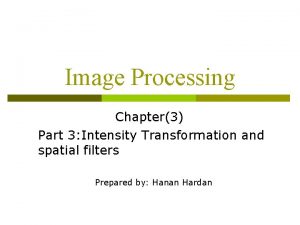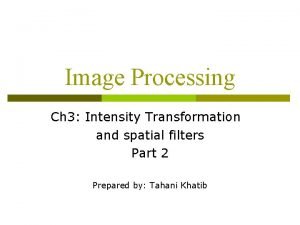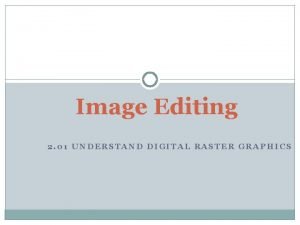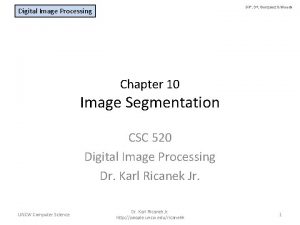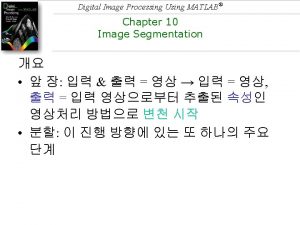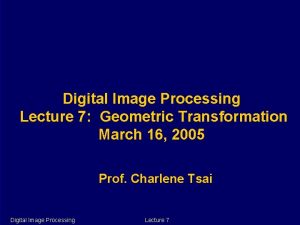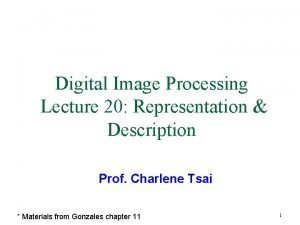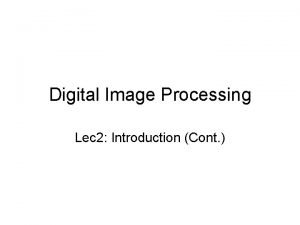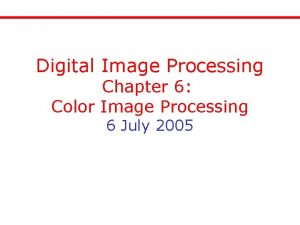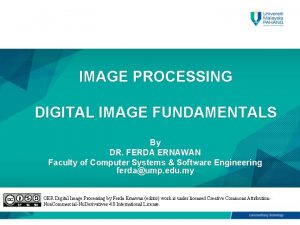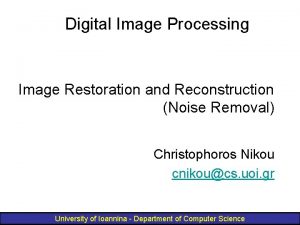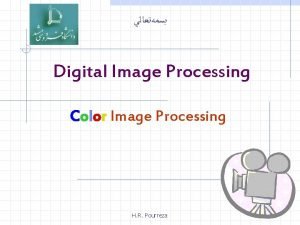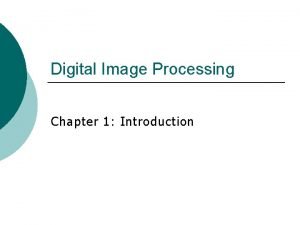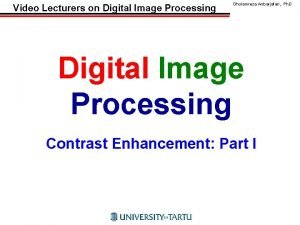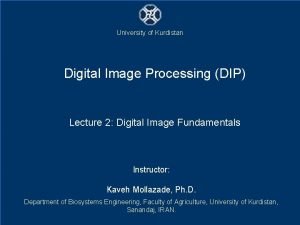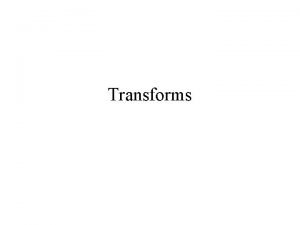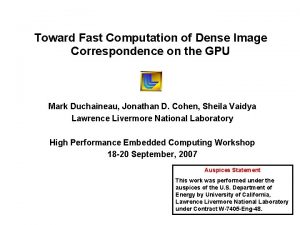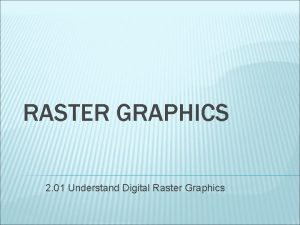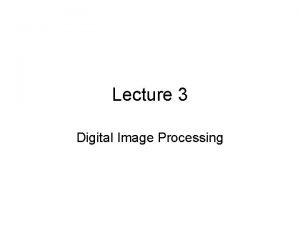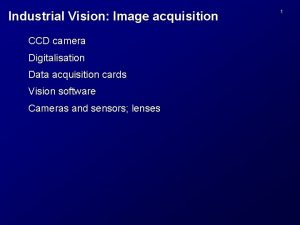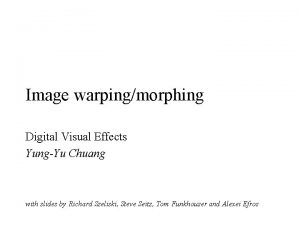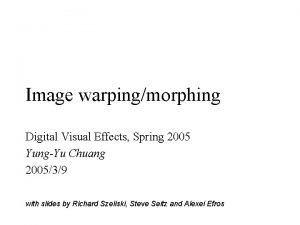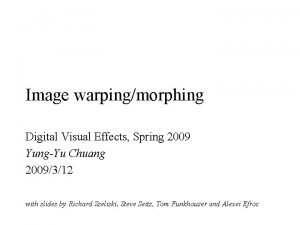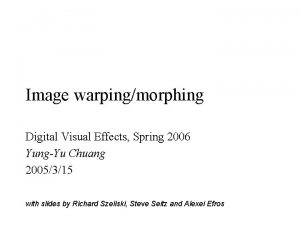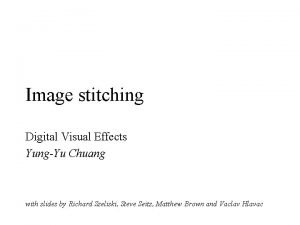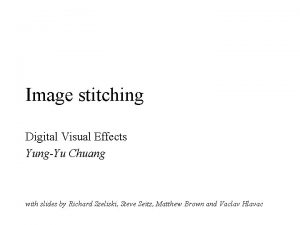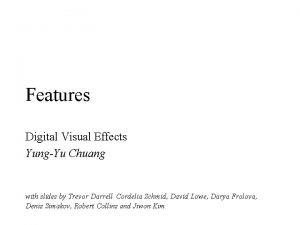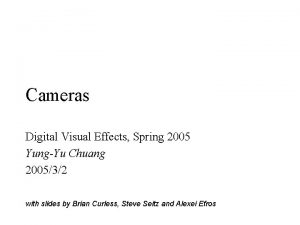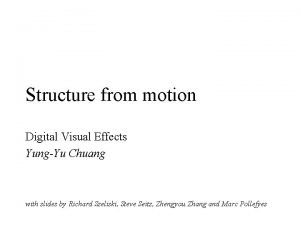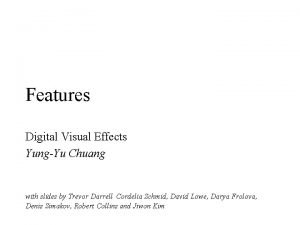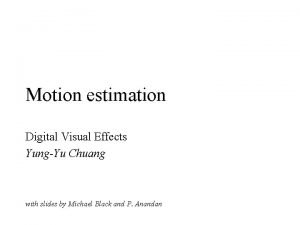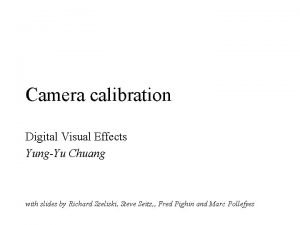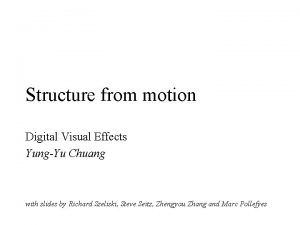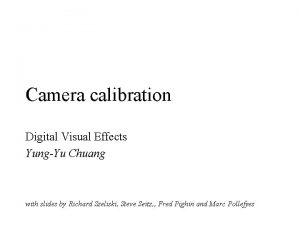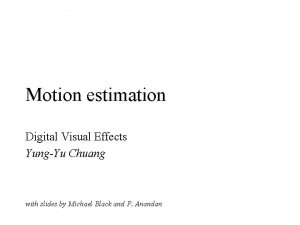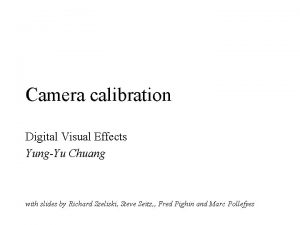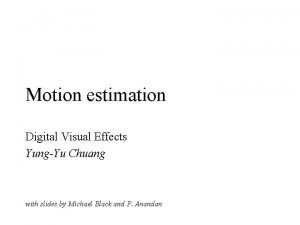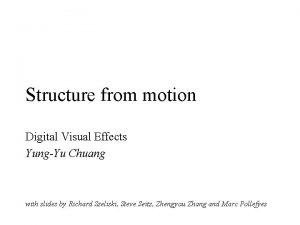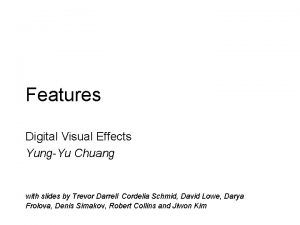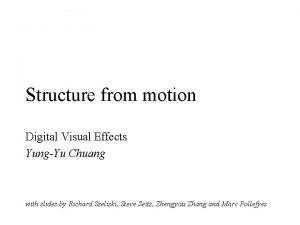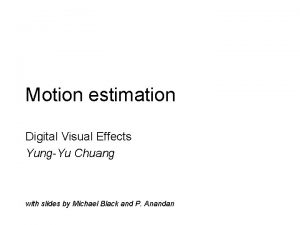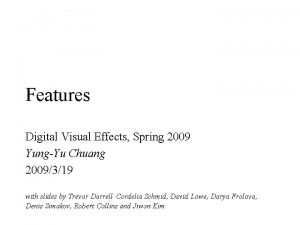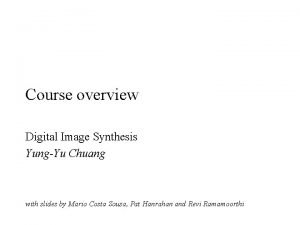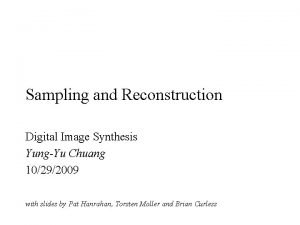Image warpingmorphing Digital Visual Effects YungYu Chuang with










































































































- Slides: 106

Image warping/morphing Digital Visual Effects Yung-Yu Chuang with slides by Richard Szeliski, Steve Seitz, Tom Funkhouser and Alexei Efros

Image warping

Image formation B A

Sampling and quantization

What is an image • We can think of an image as a function, f: R 2 R: – f(x, y) gives the intensity at position (x, y) – defined over a rectangle, with a finite range: • f: [a, b]x[c, d] [0, 1] f y • A color image x

A digital image • We usually operate on digital (discrete) images: – Sample the 2 D space on a regular grid – Quantize each sample (round to nearest integer) • If our samples are D apart, we can write this as: f[i , j] = Quantize{ f(i D, j D) } • The image can now be represented as a matrix of integer values

Image warping image filtering: change range of image g(x) = h(f(x)) f g h(y)=0. 5 y+0. 5 h x x image warping: change domain of image g(x) = f(h(x)) h(y)=2 y f g h x x

Image warping image filtering: change range of image g(x) = h(f(x)) h(y)=0. 5 y+0. 5 f g h image warping: change domain of image g(x) = f(h(x)) h([x, y])=[x, y/2] f h g

Parametric (global) warping Examples of parametric warps: translation affine rotation perspective aspect cylindrical

Parametric (global) warping T p = (x, y) p’ = (x’, y’) • Transformation T is a coordinate-changing machine: p’ = T(p) • What does it mean that T is global? – Is the same for any point p – can be described by just a few numbers (parameters) • Represent T as a matrix: p’ = M*p

Scaling • Scaling a coordinate means multiplying each of its components by a scalar • Uniform scaling means this scalar is the same for all components: g f 2

Scaling • Non-uniform scaling: different scalars per component: x 2, y 0. 5

Scaling • Scaling operation: • Or, in matrix form: scaling matrix S What’s inverse of S?

2 -D Rotation • This is easy to capture in matrix form: R • Even though sin(q) and cos(q) are nonlinear to q, – x’ is a linear combination of x and y – y’ is a linear combination of x and y • What is the inverse transformation? – Rotation by –q – For rotation matrices, det(R) = 1 so

2 x 2 Matrices • What types of transformations can be represented with a 2 x 2 matrix? 2 D Identity? 2 D Scale around (0, 0)?

2 x 2 Matrices • What types of transformations can be represented with a 2 x 2 matrix? 2 D Rotate around (0, 0)? 2 D Shear?

2 x 2 Matrices • What types of transformations can be represented with a 2 x 2 matrix? 2 D Mirror about Y axis? 2 D Mirror over (0, 0)?

All 2 D Linear Transformations • Linear transformations are combinations of … – – Scale, Rotation, Shear, and Mirror • Properties of linear transformations: – – – Origin maps to origin Lines map to lines Parallel lines remain parallel Ratios are preserved Closed under composition

2 x 2 Matrices • What types of transformations can not be represented with a 2 x 2 matrix? 2 D Translation? NO! Only linear 2 D transformations can be represented with a 2 x 2 matrix

Translation • Example of translation tx = 2 ty = 1 Homogeneous Coordinates

Affine Transformations • Affine transformations are combinations of … – Linear transformations, and – Translations • Properties of affine transformations: – – – Origin does not necessarily map to origin Lines map to lines Parallel lines remain parallel Ratios are preserved Closed under composition Models change of basis

Projective Transformations • Projective transformations … – Affine transformations, and – Projective warps • Properties of projective transformations: – – – Origin does not necessarily map to origin Lines map to lines Parallel lines do not necessarily remain parallel Ratios are not preserved Closed under composition Models change of basis

Image warping • Given a coordinate transform x’ = T(x) and a source image I(x), how do we compute a transformed image I’(x’) = I(T(x))? T(x) x I(x) x’ I’(x’)

Forward warping • Send each pixel I(x) to its corresponding location x’ = T(x) in I’(x’) T(x) x I(x) x’ I’(x’)

Forward warping fwarp(I, I’, T) { for (y=0; y<I. height; y++) for (x=0; x<I. width; x++) { (x’, y’)=T(x, y); I’(x’, y’)=I(x, y); } } I T I’ x x’

Forward warping Some destination may not be covered Many source pixels could map to the same destination

Forward warping • Send each pixel I(x) to its corresponding location x’ = T(x) in I’(x’) • What if pixel lands “between” two pixels? • Will be there holes? • Answer: add “contribution” to several pixels, normalize later (splatting) h(x) x f(x) x’ g(x’)

Forward warping fwarp(I, I’, T) { for (y=0; y<I. height; y++) for (x=0; x<I. width; x++) { (x’, y’)=T(x, y); Splatting(I’, x’, y’, I(x, y), kernel); } } I I’ T x x’

Inverse warping • Get each pixel I’(x’) from its corresponding location x = T-1(x’) in I(x) T-1(x’) x I(x) x’ I’(x’)

Inverse warping iwarp(I, I’, T) { for (y=0; y<I’. height; y++) for (x=0; x<I’. width; x++) { (x, y)=T-1(x’, y’); I’(x’, y’)=I(x, y); } } T-1 I I’ x x’

Inverse warping • Get each pixel I’(x’) from its corresponding location x = T-1(x’) in I(x) • What if pixel comes from “between” two pixels? • Answer: resample color value from interpolated (prefiltered) source image x f(x) x’ g(x’)

Inverse warping iwarp(I, I’, T) { for (y=0; y<I’. height; y++) for (x=0; x<I’. width; x++) { (x, y)=T-1(x’, y’); I’(x’, y’)=Reconstruct(I, x, y, kernel); } } T-1 I I’ x x’

Inverse warping • No hole, but must resample • What value should you take for non-integer coordinate? Closest one?

Inverse warping • It could cause aliasing

Reconstruction • Reconstruction generates an approximation to the original function. Error is called aliasing. sampling sample value sample position reconstruction

Reconstruction • Computed weighted sum of pixel neighborhood; output is weighted average of input, where weights are normalized values of filter kernel k p d q width color=0; weights=0; for all q’s dist < width d = dist(p, q); w = kernel(d); color += w*q. color; weights += w; p. Color = color/weights;

Triangle filter

Gaussian filter

Sampling band limited

Reconstruction The reconstructed function is obtained by interpolating among the samples in some manner

Reconstruction (interpolation) • Possible reconstruction filters (kernels): – – nearest neighbor bilinear bicubic sinc (optimal reconstruction)

Bilinear interpolation (triangle filter) • A simple method for resampling images

Non-parametric image warping • Specify a more detailed warp function • Splines, meshes, optical flow (per-pixel motion)

Non-parametric image warping • Mappings implied by correspondences • Inverse warping ? P’

Non-parametric image warping Barycentric coordinate P P’

Barycentric coordinates

Non-parametric image warping Barycentric coordinate

Non-parametric image warping Gaussian thin plate spline radial basis function

Image warping • Warping is a useful operation for mosaics, video matching, view interpolation and so on.

An application of image warping: face beautification

Data-driven facial beautification

Facial beautification

Facial beautification

Facial beautification

Training set • Face images – 92 young Caucasian female – 33 young Caucasian male

Feature extraction

Feature extraction • Extract 84 feature points by BTSM • Delaunay triangulation -> 234 D distance vector (normalized by the square root of face area) BTSM scatter plot for all training faces 234 D vector

Beautification engine

Support vector regression (SVR) • Similar concept to SVM, but for regression • RBF kernels • fb(v)

Beautification process • Given the normalized distance vector v, generate a nearby vector v’ so that fb(v’) > fb(v) • Two options – KNN-based – SVR-based

KNN-based beautification 5. 1 4. 3 3. 1 v' v 4. 5 5. 3 4. 6

SVR-based beautification • Directly use fb to seek v’ • Use standard no-derivative direction set method for minimization • Features were reduced to 35 D by PCA

SVR-based beautification • Problems: it sometimes yields distance vectors corresponding to invalid human face • Solution: add log-likelihood term (LP) • LP is approximated by modeling face space as a ’s i-th multivariate Gaussian distribution component u’s projection in PCA space i-th eigenvalue

PCA λ 2 λ 1

Embedding and warping

Distance embedding • Convert modified distance vector v’ to a new face landmark 1 if i and j belong to different facial features 10 otherwise • A graph drawing problem referred to as a stress minimization problem, solved by LM algorithm for non-linear minimization

Distance embedding • Post processing to enforce similarity transform for features on eyes by minimizing

Original K=3 K=5 SVR

Results (in training set)

User study

Results (not in training set)

By parts eyes mouth full

Different degrees 50% 100%

Facial collage

Results • video

Image morphing

Image morphing • The goal is to synthesize a fluid transformation from one image to another. • Cross dissolving is a common transition between cuts, but it is not good for morphing because of the ghosting effects. image #1 dissolving image #2

Artifacts of cross-dissolving http: //www. salavon. com/

Image morphing • Why ghosting? • Morphing = warping + cross-dissolving shape (geometric) color (photometric)

Image morphing image #1 warp cross-dissolving morphing image #2 warp

Morphing sequence

Face averaging by morphing average faces

Image morphing create a morphing sequence: for each time t 1. Create an intermediate warping field (by interpolation) 2. Warp both images towards it 3. Cross-dissolve the colors in the newly warped images t=0. 33 t=1

An ideal example (in 2004) t=0 morphing t=0. 25 t=0. 75 t=1

An ideal example t=0 middle face (t=0. 5) t=1

Warp specification (mesh warping) • How can we specify the warp? 1. Specify corresponding spline control points interpolate to a complete warping function easy to implement, but less expressive

Warp specification • How can we specify the warp 2. Specify corresponding points • interpolate to a complete warping function

Solution: convert to mesh warping 1. Define a triangular mesh over the points – Same mesh in both images! – Now we have triangle-to-triangle correspondences 2. Warp each triangle separately from source to destination – How do we warp a triangle? – 3 points = affine warp! – Just like texture mapping

Warp specification (field warping) • How can we specify the warp? 3. Specify corresponding vectors • interpolate to a complete warping function • The Beier & Neely Algorithm

Beier&Neely (SIGGRAPH 1992) • Single line-pair PQ to P’Q’:

Algorithm (single line-pair) • For each X in the destination image: 1. Find the corresponding u, v 2. Find X’ in the source image for that u, v 3. destination. Image(X) = source. Image(X’) • Examples: Affine transformation

Multiple Lines length = length of the line segment, dist = distance to line segment The influence of a, p, b. The same as the average of Xi’

Full Algorithm

Resulting warp

Comparison to mesh morphing • Pros: more expressive • Cons: speed and control

Warp interpolation • How do we create an intermediate warp at time t? – linear interpolation for line end-points – But, a line rotating 180 degrees will become 0 length in the middle – One solution is to interpolate line mid-point and orientation angle t=0 t=1

Animation

Animated sequences • Specify keyframes and interpolate the lines for the inbetween frames • Require a lot of tweaking

Results Michael Jackson’s MTV “Black or White”

Multi-source morphing

Multi-source morphing

References • Thaddeus Beier, Shawn Neely, Feature-Based Image Metamorphosis, SIGGRAPH 1992, pp 35 -42. • Detlef Ruprecht, Heinrich Muller, Image Warping with Scattered Data Interpolation, IEEE Computer Graphics and Applications, March 1995, pp 37 -43. • Seung-Yong Lee, Kyung-Yong Chwa, Sung Yong Shin, Image Metamorphosis Using Snakes and Free-Form Deformations, SIGGRAPH 1995. • Seungyong Lee, Wolberg, G. , Sung Yong Shin, Polymorph: morphing among multiple images, IEEE Computer Graphics and Applications, Vol. 18, No. 1, 1998, pp 58 -71. • Peinsheng Gao, Thomas Sederberg, A work minimization approach to image morphing, The Visual Computer, 1998, pp 390 -400. • George Wolberg, Image morphing: a survey, The Visual Computer, 1998, pp 360 -372. • Data-Driven Enhancement of Facial Attractiveness, SIGGRAPH 2008

Project #1: image morphing

Reference software • Morphing software review • I used Fanta. Morph 30 -day evaluation version. You can use any one you like.

Morphing is not only for faces

Morphing is not only for faces
 Translate
Translate What is image restoration in digital image processing
What is image restoration in digital image processing Compression models in digital image processing
Compression models in digital image processing Image segmentation in digital image processing
Image segmentation in digital image processing Analog image and digital image
Analog image and digital image Error free compression in digital image processing
Error free compression in digital image processing Image sharpening in digital image processing
Image sharpening in digital image processing Image geometry in digital image processing
Image geometry in digital image processing Steps of image processing
Steps of image processing Digital image processing
Digital image processing Maketform matlab
Maketform matlab Noise
Noise Nielsen chuang
Nielsen chuang Chuang qian ming yue guang li bai
Chuang qian ming yue guang li bai Liăn
Liăn Nielsen chuang
Nielsen chuang Zi chuang
Zi chuang Pierce chuang
Pierce chuang Chuang
Chuang Cathy chuang
Cathy chuang Rosalind chuang
Rosalind chuang Chuang pronunciation
Chuang pronunciation Visual effects meet
Visual effects meet Perbedaan pemrograman konvensional dan pemrograman visual
Perbedaan pemrograman konvensional dan pemrograman visual Hamid rahim sheikh
Hamid rahim sheikh Visual basic image processing
Visual basic image processing Imagery in casey at the bat
Imagery in casey at the bat Warga digital merupakan
Warga digital merupakan Digital market and digital goods
Digital market and digital goods Digital data digital signals
Digital data digital signals Digital data transmission
Digital data transmission E-commerce: digital markets, digital goods
E-commerce: digital markets, digital goods Digital encoding schemes
Digital encoding schemes Luxinnovation logo
Luxinnovation logo E-commerce digital markets digital goods
E-commerce digital markets digital goods Mpp algorithm in image processing
Mpp algorithm in image processing Representation and description in digital image processing
Representation and description in digital image processing Double thresholding matlab
Double thresholding matlab Segmentation in digital image processing
Segmentation in digital image processing Relationships between pixels
Relationships between pixels Intensity transform function
Intensity transform function Zooming and shrinking in digital image processing
Zooming and shrinking in digital image processing Digital photography with flash and no-flash image pairs
Digital photography with flash and no-flash image pairs Digital imagery definition
Digital imagery definition Imadjust
Imadjust Consider an image p, the distance d is also called as
Consider an image p, the distance d is also called as Coordinate conventions in digital image processing
Coordinate conventions in digital image processing Dam construction in image processing
Dam construction in image processing Digital image processing java
Digital image processing java Thresholding in digital image processing
Thresholding in digital image processing Filteration
Filteration Spatial filtering in digital image processing
Spatial filtering in digital image processing Histogram processing in digital image processing
Histogram processing in digital image processing Representation and description in digital image processing
Representation and description in digital image processing Optimum global thresholding using otsu's method
Optimum global thresholding using otsu's method What is boundary descriptors in digital image processing
What is boundary descriptors in digital image processing Color slicing image processing
Color slicing image processing Forensic duplicates as admissible evidence
Forensic duplicates as admissible evidence Intensity transformation in digital image processing
Intensity transformation in digital image processing Intensity transformations and spatial filtering
Intensity transformations and spatial filtering Fourier image processing
Fourier image processing Padded size matlab
Padded size matlab Digital image processing
Digital image processing Walsh transform for n=8
Walsh transform for n=8 Coding redundancy in digital image processing
Coding redundancy in digital image processing Lossy compression in digital image processing
Lossy compression in digital image processing Digital image processing
Digital image processing What is mach band effect in digital image processing
What is mach band effect in digital image processing Filetype:ppt
Filetype:ppt Digital image processing
Digital image processing Color fundamentals in digital image processing
Color fundamentals in digital image processing Image processing
Image processing Static image vs dynamic
Static image vs dynamic Neighborhood processing in image processing
Neighborhood processing in image processing Digital path in image processing
Digital path in image processing Digital path in image processing
Digital path in image processing 472
472 Intensity level slicing in image processing
Intensity level slicing in image processing Intensity level slicing
Intensity level slicing Define incongrous
Define incongrous Digital image processing
Digital image processing 매트랩 .* 의미
매트랩 .* 의미 Fluorocein
Fluorocein Nonlinear image processing
Nonlinear image processing For a chain code :10103322
For a chain code :10103322 Components of image processing
Components of image processing Point processing
Point processing Fractal
Fractal When was this picture taken
When was this picture taken Thinning and thickening in image processing example
Thinning and thickening in image processing example Full color image processing
Full color image processing Spatial resolution in digital image processing
Spatial resolution in digital image processing Formation d'image
Formation d'image Digital image processing
Digital image processing Digital image processing
Digital image processing Color transformation in digital image processing
Color transformation in digital image processing Block diagram for image processing
Block diagram for image processing Patterns and pattern classes in digital image processing
Patterns and pattern classes in digital image processing Digital image 2006
Digital image 2006 Digital image processing
Digital image processing Digital image processing
Digital image processing Hadamard transform in digital image processing
Hadamard transform in digital image processing Dense image
Dense image Digital raster graphic
Digital raster graphic Aliasing in image processing
Aliasing in image processing Shape numbers in digital image processing
Shape numbers in digital image processing Digital image acquisition for analog sem
Digital image acquisition for analog sem












